I’ve played a b’zillion jazz piano and banjo gigs over the past 60 years. None can compare, however, with my long-time gig at Capone’s Chicago Tea Room in my hometown of Sacramento, California. It was by far the most fun I ever had in the music business. Thinking back about those crazy years, I decided to write down my recollections of the joint and to contact some of my old friends and acquaintances from those years. I discovered that many of them also valued highly their own memories of Capone’s. I’ve tried to put them all together here and it’s evolved into quite a story which I hope you will enjoy.
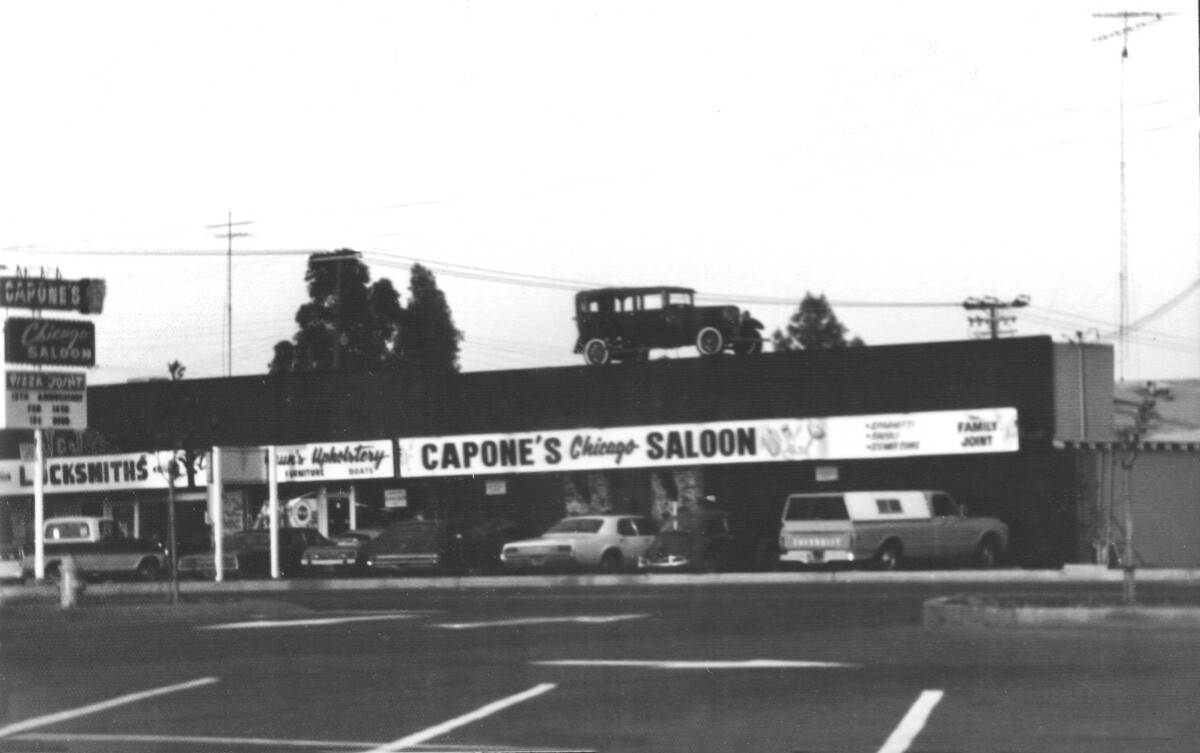
Capone’s Chicago Tea Room and Pizza Joint opened in Sacramento, California, in 1960. It was located at 1970 Fulton Ave. The grand opening advertisement read, “It’s 1920 in 1960 at 1970.” The owners initially wanted to use the word “Speakeasy” in the name but using that word was prohibited by law.
In the beginning, Capone’s was owned by four partners: Carlo Giordano, Vic Mikulin, Ed Slavich, and Dick O’Cane. Carlo, Vic, and Ed had been friends since grammar school and Dick was Vic’s brother-in-law. In approximately 1962, Dick sold his one-quarter share of Capone’s to Vic and opened his own Capone’s-type nightclub named The Warehouse in Monterey, California. In 1965, Vic and Ed sold their shares of the club to Carlo. Until then, Vic had been the manager. Carlo then, as sole owner, took over the managerial duties. Vic opened his own bar in Sacramento called The Glass Turtle. Ed owned a vending machine company which had been his family’s business for many years.
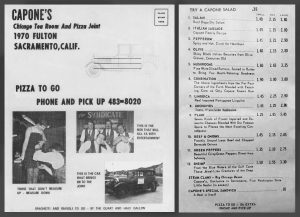
Capone’s theme was “Roaring Twenties Speakeasy.” There was a 1928 Hudson car on the roof. To enter, a customer had to go into a fake telephone booth and turn the crank on the old-fashioned telephone and then push on the rear wall which would open into the club. I was a member of the band and, often, during our breaks, we would go outside and observe customers trying to figure out how to get in. The pizza kitchen was in the front and could be seen from the outside through a large glass window. The cooks sometimes also went outside to show people how to get in.
Inside, there were paintings on the walls depicting the 1920s Prohibition Era including the St. Valentine’s Day Massacre. The paintings were originally done by Dick O’Cane’s brother Harold. When Capone’s was expanded in 1970, one of the painted walls was demolished; those paintings were recreated with a few subtle changes by Frank Harris, one of Capone’s pizza cooks.
The walk-in refrigerator had a sign over the door that said “Property of Sacramento County Morgue.” There was a large poster of Al Capone behind the bar with the words “Rest in peace Big Al.” There were racing results running on a continuous tape (crawl) over the bar. The tables had roulette numbers painted on the tops. There was a coin-operated piano that played a piano roll for a dime. The employees dressed in period clothes, i.e. bartenders in vests, garters, and shoulder holsters and the waitresses in skimpy (for those days), sexy, flapper-type fringed dresses.
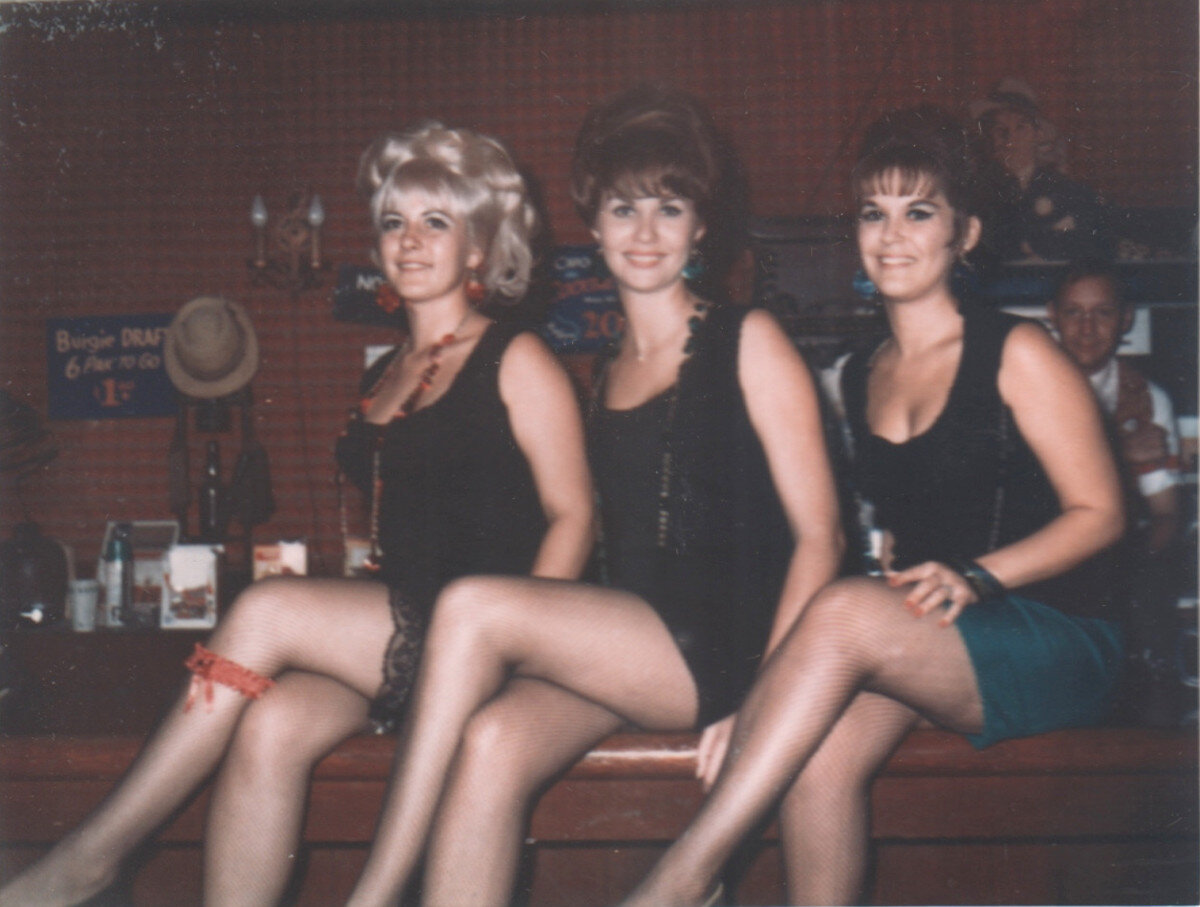
In the 1960s and ’70s, Capone’s was the place to go in Sacramento. With Mather and McClellan Air Force Bases close by, plus several colleges, there was no shortage of young, single, unattached men and women who made Capone’s their “home away from home.”
In 1960 and 1961, I was playing piano on Fridays and Saturdays in various nightclubs in the Sacramento area with The Gad Abouts, a trio with Hal Nedved on saxophone and trumpet, and Buddy Trumbo on drums. On Sundays, I played solo piano at Shakey’s Pizza Parlor in Roseville, California, for a short time, until it burned down. That was my first experience playing ragtime, honky-tonk, and jazz.
Soon after that, in 1961, I began working Wednesdays and Thursdays at Capone’s with Don Lewis on banjo.
In 1962, I went to work playing piano Thursdays through Sundays at Slick and Red’s Pizza Pub in Fair Oaks, California, with Bill Baker on gut bucket and Will Tallicksen and Jerry Cordy alternating Fridays and Saturdays on banjo, while continuing to play at Capone’s on Wednesdays. Will had actually played for Al Capone in his speakeasies in Chicago in the ’20s and regaled us with some of his experiences.
He told us about the night that he and four other musicians were all trying to hide behind the piano at the same time because a gun battle had broken out in the audience. Another time the band came to work and found that the club had been raided and closed by the Feds. They were devastated because they had left their instruments overnight and they were nowhere to be found. They thought that they had been confiscated or stolen. Happily, someone had been tipped off and their instruments were found safe next door in a funeral parlor. They then called a secret phone number and received instructions as to where to play that night. During Prohibition, as fast as a speakeasy was raided and closed by the Feds, two more would open.
In 1965, I left Slick and Red’s to work full-time, five nights a week, at Capone’s. My off-nights were Mondays and Tuesdays. Some nights, I played solo and others with a band; the style was honky-tonk, jazz, and comedy. I stayed at Capone’s for the next 13 years, for a total of 16 ½ years. During that time, I also worked many other gigs: cocktail hours, brunches, picnics, after-hours, private parties, funerals, super-market openings, etc.
I remember one night, after working at Capone’s until 2:00 AM, getting paid $100 to drive all night to somewhere on the north coast of California to play for 15 minutes. I recall being hired to provide the music for four strippers. I played for a political rally for Jimmy Carter the day before he won the election for president. I also played a rally for presidential candidate George McGovern. Still another gig was playing for a John Birch Society picnic where the door prize was the biggest rifle you ever saw, with a telescopic scope. A strange prize for a political organization to be giving away, wouldn’t you think?
Capone’s was not your regular family pizza parlor. There was a section in the back which was roped off for customers who were under age (under 21 years old). Most of the entertainment, at least on Friday and Saturday nights, was definitely not suitable for younger children.
The following are some of the gags and stunts that occurred at Capone’s. Hopefully, this will give an idea of the fun the employees and customers had which kept patrons coming back week after week, year after year. Bear in mind that some of our stunts would certainly not be Politically Correct with today’s “MeToo” movement. Times were different then; this was 40 to 60 years ago. I can confidently report that the girls loved the gags as much as the guys. It was always one big, happy, party at Capone’s.
Shortly after opening in 1960, Capone’s staged a fake robbery for publicity, with a tire on a car being shot out. Also, in the same year, a piano was hoisted onto the roof of the club for Roger Snell to do a jazz piano playing marathon. He lasted over 50 hours. This event made the local TV news and caused a huge traffic jam on Fulton Ave. in front of Capone’s.
When the Batman TV series became popular, Capone’s put Steve Milar dressed as Batman on the roof with a port-a-potty, bed, and telephone. Kids were excited to call and talk to Batman. He was on the roof 24 hours a day for a month. One night, he spotted two men breaking into a car across the street. He called the police. The next day, newspapers across the country reported “Batman Foils Crime!”
When the movie Cool Hand Luke was popular, there was a scene where Paul Newman bet that he could eat fifty hard-boiled eggs in one hour. So, Capone’s had hard-boiled egg eating contests.
For publicity, Carlo put on Capone’s own fake political campaigns. There were t-shirts, bumper stickers, signs and newspaper advertisements proclaiming “Al Capone for Governor” or “Al Capone for President” depending on the year of the real political campaigns.
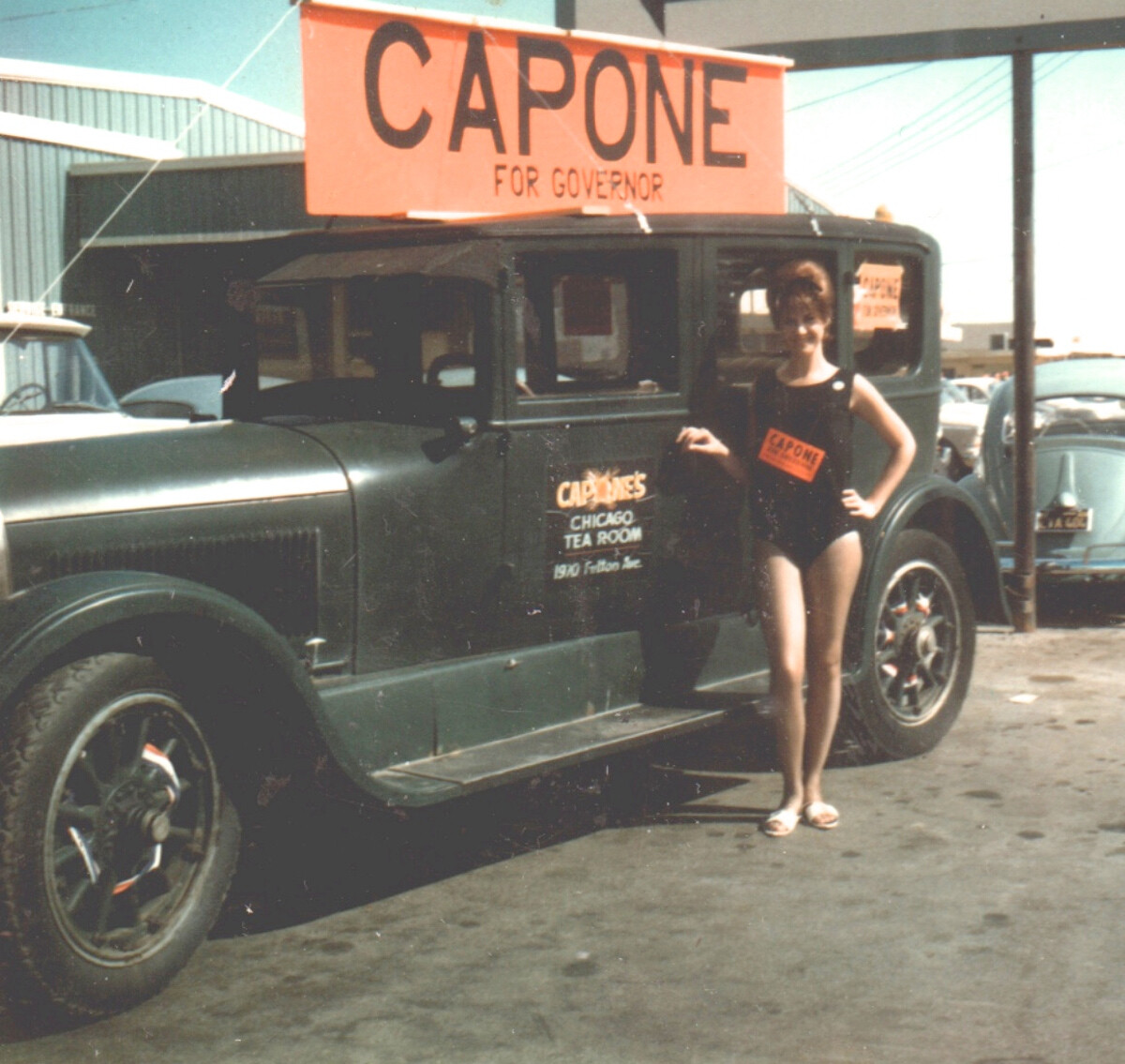
There was an 86-ounce beer mug behind the bar. If someone could drink the 86 ounces in five minutes and keep it down for another five minutes, he/she would get $5 plus the beer free. Lots of people, mostly men, tried and failed.
One night I was on a break sitting at the bar when a customer came in and had a couple beers. He asked about the large beer mug and was told about the contest. He accepted the challenge and drank the 86 ounces of beer in one minute and sixteen seconds. While waiting for the five minutes to be up, he drank another two beers. It was amazing! Several weeks later, we had a final “drink-off” between him and another customer who had previously downed the 86 ounces in one minute and seventeen seconds. I don’t remember who won but the winner got $50, plus probably a huge stomach ache.
There was a local TV sports announcer who used to do the Six O’clock News and then come into Capone’s for a few belts before going back to the studio for the 10:00 PM show. One night, our bartender started feeding him free drinks and got him loaded. We all had fun watching him on the news struggling to maintain. On another night in 1976, after visiting Capone’s for a little too long, he was doing the TV sports news and reporting on the Bicentennial Golf Tournament. He accidently said, “Bisexual Golf Tournament.” He then looked up at the camera with a stricken look on his face and said, “Does this mean I’m fired???”
There were contests as follows: name-the-song, wet t-shirt, beer-chugging, tongue-twisters, who wore the shortest mini-skirt, and many more audience participation contests and events with the winners being awarded a free pitcher of beer.
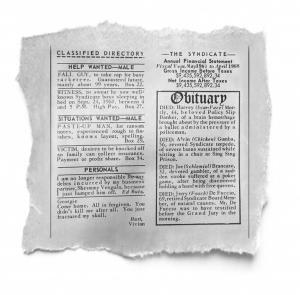
There were sing-alongs with printed song sheets. One of the songs was a German drinking song written in phonetic English titled “Eins Zwei G’Suffa,” translated, “One Two Guzzle” or “Chug Your Drink.” We had our own version of The Gong Show with members of the audience performing (or in most cases trying to perform) on stage. We sang “Hey Lotty Lotty Low” with audience members joining in and singing many x-rated verses.
Carlo had t-shirts made for the girls that had the word “UNTOUCHABLES” across the front. We would often ask for volunteers to model the shirt on stage. Unbeknownst to the models, the shirt would be switched. The girl would end up modeling a shirt that said “UNFINDABLES.” She would momentarily be embarrassed; but the audience, both women as well as men, loved the gag.
We made a tape recording blowing into a glass of water through a straw. It sounded like someone using a toilet. We added a few grunts and fart sounds and then the sound of someone throwing up and a toilet flushing. We would watch for a couple of girls to go to the restroom together and then tell the audience that we were going to turn on a hidden microphone in the bathroom. I would then start the recording. When the girls came out, the audience would give them a big hand. When they got back to their table, their friends would tell them that there was a hidden microphone in the restroom. Gawd only knows what, or who they had really been talking about. Needless to say, they were completely embarrassed and mortified for a few moments until they realized that it was all in fun. Everyone in the audience loved the gag, women as well as men.
As mentioned above, in the early years of Capone’s, I worked with a banjo player named Don Lewis. One night, someone in the audience was shooting Don with a water pistol. When he discovered who it was, Don, who had only one leg and used crutches, got off the stage in the middle of a song and calmly poured an entire pitcher of beer over the culprit’s head.
From time to time, the 40-piece Ophir Prison Marching and Kazoo Band Temperance Society Ltd. would come crashing in the front door, march around the room playing and then march out the back door. Sometimes we would keep playing as if we were oblivious to the fact that a 40 piece band had just marched through the club playing.

In 1964, the famous stripper Carol Doda made news by dancing completely topless at the Condor Club in San Francisco. In 1965, she made even more news when she began dancing totally bottomless. Our boss Carlo had the clever idea to advertise that there would be a topless show at Capone’s. He ran ads in the local newspapers. One of our regular customers, Ken Reiman, who was a pilot in the Strategic Air Command at Mather Air Force Base, called a local radio station talk-show and conned them into broadcasting a serious discussion on the morality of a Sacramento pizza parlor having topless entertainment. The police were on hand for the first night that topless was to be presented at Capone’s. They were prepared to arrest the entertainers along with the owner. They were as surprised (and maybe shocked and disappointed) as the audience when, at show-time, we, the band, came out with our shirts off!
We continued our part of the gag for a couple weeks. Then, our banjo player Roger Reitano, who was also a teacher at Bella Vista High School, began dressing in drag and performing a comedy topless show as Rotten Rogina. This made Capone’s even more popular and famous.
In 1967, Roger quit Capone’s to move to Tok Junction, Alaska, to race sled dogs and teach school. Art Terry, a longtime Capone’s customer, joined the band playing gut bucket (wash tub bass). His first gut bucket was constructed for him by Bill Baker who was playing at Slick and Red’s Pizza Pub. Art took over doing the comedy topless show as Miss Honey Carriage (Miss Carriage) and added more gags, pushing the boundaries even further than those Roger had set.
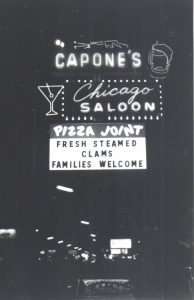
Until 1970, Capone’s served only beer and wine along with their famous pizza, sandwiches and steamed clams. That year, Carlo obtained a hard liquor license and began serving a selection of alcoholic beverages. He also remodeled the club, doubling its size to accommodate 300 patrons and expanded the food menu. We would often have 450 customers in the house. The band would have to stop playing until enough people would leave so the city fire-marshal wouldn’t close us down.
In 1966, one of Al Capone’s brothers came into Capone’s. He claimed to be a haberdasher from Chicago and looked very much like Al. He loved the club, especially the picture of his brother behind the bar.
Also in 1966, Carlo’s parents were vacationing in Italy and brought a girl back with them to see America. Even though she could not speak English and Carlo could not speak Italian, they fell in love and were married. As of this writing, they have been married 53 years with two children and five grandchildren. Carlo still can’t speak Italian, but Francesca is now very fluent in English.
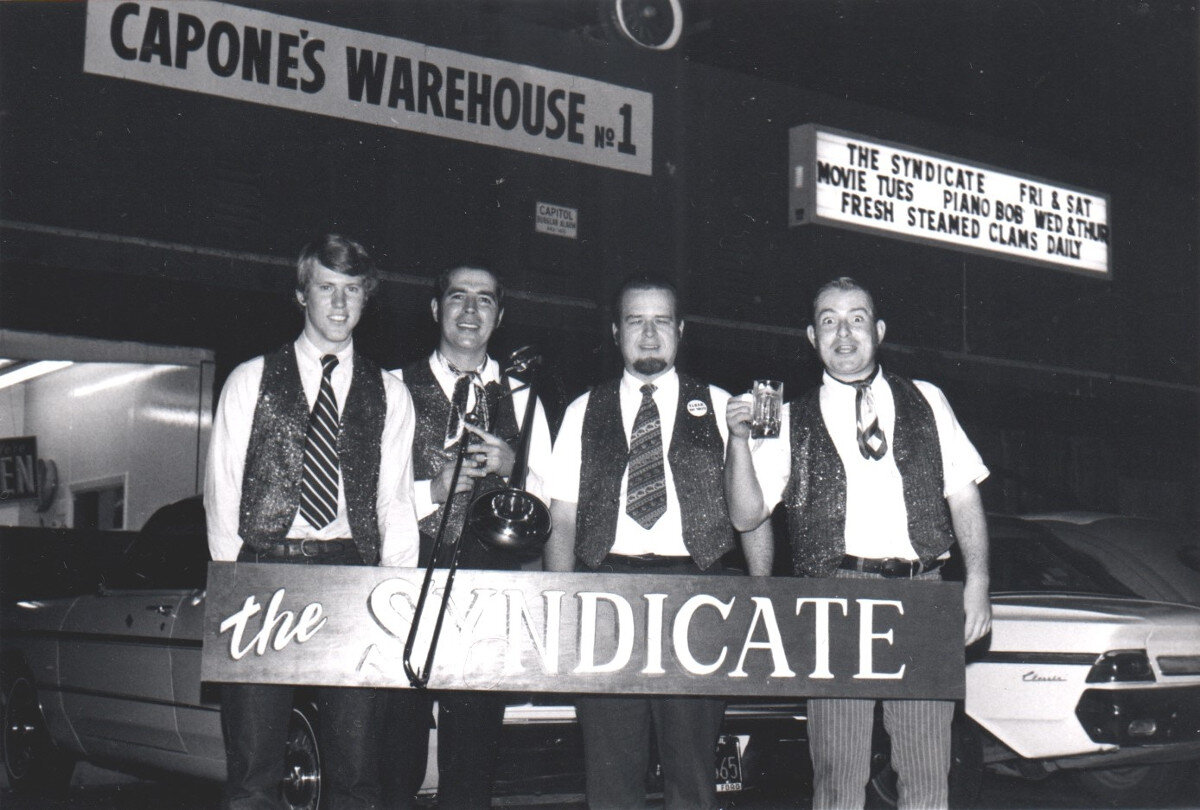
When Roger Reitano began playing banjo at Capone’s in 1962 with George Goodwin, piano, and Roy Wahl, banjo, the band was named “The Flat Bottom Trio.” Later when the band was expanded to 4 and 5 pieces, it was renamed “The Syndicate.” Sometime later, in 1968 or 1969, Bill Gunter, who had been playing at Johnny and Red’s Pizza Pub and, before that, The Boondocks in Walnut Grove, California, joined the band on washboard and the name was changed to “The Boondockers.” Shortly after Bill joined the band, multi-instrumentalist Jim Maihack, who had also worked at Johnny & Red’s, Rosie O’Grady’s in Orlando, FL, and with Clyde McCoy of “Sugar Blues” fame, joined the band for a short time on trombone before joining the renowned Turk Murphy Jazz Band on tuba in San Francisco.

In 1998, The Boondockers reunited to play the Sacramento Dixieland Jazz Festival/Jubilee. The band was so well accepted that we continued to play jazz festivals and private parties including several International Washboard Festivals in Logan, Ohio. In 2004, we were featured at the International Bohém Ragtime & Jazz Festival in Kecskemét, Hungary.
Often, on Monday nights, Carlo would hire famous jazz bands for special concerts. Some of the bands were Turk Murphy’s San Francisco Jazz Band featuring Pat Yankee, The Legends of Jass from New Orleans and Los Angeles, Max Collie’s Rhythm Aces from London, England, Trevor Richards’ Trio from England by way of New Orleans, Sugar Willie and the Cubes, Jim Maihack and the Tappers, Dutch’s Gas House Gang and my own band The Fulton Street Jazz Band.
Tuesday night was old-time silent movie night. Wednesday was lady’s night with dime beer for the ladies. This brought in lots of the fairer sex, which of course, resulted in attracting lots of the not so fair sex.
On weeknights, much to the chagrin of the musician’s union, we’d sometimes have jam sessions. As a result of these sessions, I eventually formed the Fulton Street Jazz Band. Even though Capone’s was on Fulton Avenue, I named the band Fulton Street Jazz Band because Fulton Avenue Jazz Band didn’t sound “jazzy” enough. The FSJB went on to be the only band out of a thousand bands to play all 44 of the annual international Sacramento Dixieland Jazz Festivals/Jubilees. The band made many recordings, played hundreds of radio and TV shows, jazz cruises, jazz festivals and, as a group, consumed 1,823 kegs of beer, mostly orally.
I left the FSJB in 1979 to move to Los Angeles where I formed the Great Pacific Jazz Band with such notable musicians as Zeke Zarchy, trumpet, and Bob Havens, trombone. In 1994, I moved back to the Sacramento area and rejoined the FSJB in 1998. I took over as leader again in 2004.
Capone’s became famous throughout the world. As an example, in 2007, I was leading the Fulton Street Jazz Band at the 16th International Bohém Ragtime & Jazz Festival in Hungary. There, in the audience, I met an ex-Air Force officer who used to frequent Capone’s in its heyday. He was serving as the assistant to the U.S. ambassador to Hungary. He gave me his card and said that if I needed anything to call him. I told him that I might need help bailing my musicians out of jail.
In 2012, Sandi Meyer, a former Capone’s waitress, invited 10 ex-employees to a Capone’s reunion dinner on Sunday, June 24. The news of the get together spread like wildfire and there were over 65 former employees, musicians, and customers in attendance. One of the attendees was a waitress from 1960 who brought the original flapper-type dress that she had worn at Capone’s 52 years before!
Capone’s was a very friendly place where many long-lasting friendships were made. Many of these friendships resulted in marriages, not only customer to customer and employee to employee, but customer to employee.
Through the years, many musicians worked at Capone’s, including:
Piano: Roger Snell, Bob Ringwald, George Goodwin, Bill Richards, Bob Fischer
Banjo: Don Lewis, Roger Reitano, Ralph Thompson, Don Schumacher, Jim Snoke, Roy Wahl
Trombone: Jim Maihack, Bob Basher, Jim Snoke
Tenor sax & clarinet: Frank Silva
Gut bucket bass: Art Terry
Washboard: Bill Gunter
Drums: Buddy Trumbo, Rex Farmer, Chuck Austin, Lon Steiner, Gene Copelan, Bob Johnson, Bill Shirey
(during Bill’s drum solos, he would go into the audience and play on walls, tables, chairs, beer mugs, and even girls’ boobs).
In 1978, Carlo sold Capone’s, thus ending the two-decade reign of one of the most popular nightspots that Sacramento has ever known. There was something special about Capone’s that the thousands of employees and customers, through the years, have never forgotten. It was a remarkable time and place.
While reading and rereading this article for editing, I realize that no amount of words can convey to you, the reader, the actual feeling of Capone’s the way it was. “You had to be there.” I hope that the comments below, shared by former employees, musicians and customers, will help in some degree to illustrate this feeling.
— Robert (Bob) Ringwald, October, 2019
FOND MEMORIES of CAPONE’S
from those who were there
To me Capone’s was an experience that isn’t easily described by facts. It was a smell, a taste, a sound, a sight and a feel thrown in with a whole bunch of personal interactions with cooks, waitresses, bartenders, managers, regular and weekend customers, musicians and vendors stretched over a long period of our lives. — Art Terry, musician, Elk Grove, CA.
Luckily we didn’t have cell phones back then. No proof! Loved the band with Bill S. on drums. — Steve Warner, customer.
Loved their Singapore Slings. – Sherreta Lane, customer.
I came to Sacramento from Milwaukee to take the Band Director’s job at Encina High School in 1966. I wanted to be in California, as close to Turk Murphy’s San Francisco Jazz Band as possible. On my first night in Sacramento, after driving from Salt Lake City, I drove down Fulton Ave. and there it was; an old car on the roof, a telephone booth entrance and wild music within; my kind of place. I was taken in by the crowd, the noise and the great trio that was playing. Ringwald piano, Roger Reitano banjo and maybe Buddy Trumbo drums. Wow! I slipped the waitress $3 (a lot of money in those days) and asked her to have the piano player do the first movement of Beethoven’s Moonlight Sonata. The piano had tacks on the hammers and I really didn’t expect much. All of a sudden, I heard the Sonata and by God he was playing it correctly. I introduced myself to Bob and that was the start of a very long friendship that continues to this day. — John Knurr, musician, Milwaukee, WI.
If I remember correctly, one of our classmates (Sacramento High 1969) held the record for chugging a 60 ounce pitcher. It was not me. Anyone care to cop to it? — Bruce Edward Nelson, customer.
I always wondered about the place when we drove by and I saw the old car on the roof. I was a kid in the early to mid-70’s when my dad brought me and my brother there for pizza. We were seated in a separate area, which I now know was because we weren’t old enough to drink. The live music was the best, old-time but fun. By the time I was 21 and drove back to the area, Capone’s was gone and so was the old car. I’m still thinking about Capone’s 44 years later. I think that speaks for itself as to how unique it was. — Greg Bolling, customer, Elk Grove, CA.
My first job was at Capone’s as a waitress, “slinging beer and pizzas.” It was the most fun I’ve ever had working. It was like a party every night. A lot of the crew and some of the regular customers often went to Ancil Hoffman Park on Sundays and played softball. One rule was that if you knocked over someone’s beer, it was an automatic out. Good times, good entertainment, good pizza and beer, and the best steamed clams anywhere. When is the next reunion? — Andi (Heather) Burgdorf, Capone’s waitress.
As a teenager in the mid to late ’60s, Capone’s was a popular destination whenever my cronies and I wanted to get the feel of a real, adult nightclub. We were happy to sit in the roped off section, have some great pizza and sip Coke while enjoying the ambience and music. I think we even dared to sneak a cigarette or two. It was fun and exciting. Capone’s was the highlight of our young lives. — Dave Williams, KLIF FM/AM Radio, Dallas, TX.
My high school boyfriend used to work at Capone’s. Loved the antique car on top of the pizza parlor. If we held hands with a few people we could touch this game and feel an electric tingling go all around us in our hands. Believe it!!!!!!! — Jaki Wills, customer.
I went to work as a “barmaid” at Capone’s the summer of 1960. My husband taught at Hiram Johnson High School and we had four daughters under the age of 8; thus, the extra income was needed. I was not the barmaid type, red flapper dress and all, but I sure became one and had so much fun! I’d do a little Charleston once in a while, balancing the pizza tray on which I used to carry pitchers and glasses of beer to the tables. I learned how to holler “pitcher of half & half and 6 glasses” loud enough for the bartender to hear me. The music was always great. It didn’t matter if it was a full Dixieland jazz band or just Bob Ringwald on the piano, I loved it all! Good memories for this old lady! – Allyn Burk, Diamond Springs, CA.
When I was attending Encina High School, the band director John Knurr recruited me to play trombone with the Bell Street Housewreckers, a student Dixieland band he had organized. Every so often, he’d invite us to come to Capone’s to hear great bands like Turk Murphy, Sugar Willie and the Cubes or Jim Maihack’s Tappers. We got to hear how its supposed to be done, by the professionals. The members of these bands were great players and great people. They became my heroes. When I was attending Sacramento State University, I played with The Ophir Prison Band and remember the time we “crashed” the party at Capone’s and marched through the place while the regular band was doing their show. Capone’s was a unique and unforgettable venue, with the best music in town. Fond memories, indeed! — Mike Pittsley, trombonist formerly with The Jim Cullum Jazz Band, San Antonio, TX.
Brings back my wayward past. THOSE were the days, weren’t they? It’s a wonder we all survived. — Burt Wilson, musician, Binghamton, NY.
Loved the entrance, you walked into a phone booth, like a speakeasy. — Rebecca Martak, customer.
My family moved to Sacramento in 1967 when I was going into the 6th grade. I had started playing trumpet in Phoenix, AZ. I spent summers in Lake Tahoe where my dad played organ and piano at a steakhouse. From a young age I fell asleep to great jazz musicians playing all night in the living room. When we moved to Sacramento, Capone’s was a natural fit. In high school, I joined a youth Dixieland band, the Bell Street Housewreckers. A big part of playing in the band was our performances at Capone’s. When I got to Sacramento State University, I joined the Ophir Prison Band and found myself crashing the show at Capone’s many times. — Kurt Pearsall, musician.
It was a great date location. And the pizza was pretty good, too. — Kay Hamilton, customer.
I’ll never forget Capone’s. I remember playing there several times, as well as with the musicians mentioned here, and many more besides. I can see that place clearly in my mind. Truly a memorable place. — Al Smith, musician, Visalia, CA.
When I finally turned 21 and could drink, I loved to participate in the Capone’s customers’ tongue twister contests. The winner would win a pitcher of beer for their table. These tongue twisters would make you laugh so hard when each contestant would screw up. My favorite was:
WHEN SHE SITS SHE SHIFTS AND SITS AND WHEN SHE SHIFTS SHE SITS AND SHIFTS.
Another one was:
WHEN SHE FOLDS SHE TUCKS AND FOLDS AND WHEN SHE TUCKS SHE FOLDS AND TUCKS.
You had to say them faster and faster. Needless to say, there were some hilarious mistakes. I’ll never forget those nights at Capone’s! — Donna Danielson, customer, Lincoln, CA.
I remember the mystery involved when entering Capone’s. There was a small staging area with a door before you could walk in. — Karen Buckner, customer.
During my first time at Capone’s, Bob Ringwald’s group was playing. They ended a set with a rousing rendition of “You’re a Grand Old Flag” and an American flag dropped down from the ceiling of the stage. I’ve never forgotten that first night there. — Dann Shively, retired KCRA Channel 3 traffic reporter.
The second time I walked into Capone’s, in the winter of 1966, Carlo asked me if I wanted a job. I said no, I already worked for the State of California. He said that this would be a lot more fun. That’s how I became a waitress dressed in a bright orange flapper dress. Bill Munsterman was becoming a regular at Capone’s and soon he became the new manager/bouncer, and we became an item. What a tight-knit group of amazing people worked there. Many were able to attend the reunion in 2012. It was so much fun catching up on life, and reminiscing about Capone’s. I cherish those memories. After three children and four grandchildren, my sweet Bill passed away in May of 2017 after 50+ years of being together. — Karen Munsterman, Capone’s waitress.
At the time it was a great place to visit. Those days are gone forever. — Jerry Cordy, musician and owner of Bibbs Drive-in.
I replaced Jim Maihack on banjo and trombone for a short while after he left to play with Turk Murphy. I remember the chugging contests and Bill Gunter playing washboard. I was playing there one night when the Ophir Prison Band marched through the club playing. — Jim Snoke, musician, Weed, CA.
One of my particularly fond memories of Capone’s is the Monday night concerts I played with my 8-piece band, The Tappers. Our basic musical style was Dixieland jazz but we played all sorts of other things, including Tijuana Brass and Georgie Girl (remember that?) I wrote nearly all the arrangements, some of which were big band things like Benny Goodman’s Sing Sing Sing, which I had to scale down for 8 pieces. Our amazing Bob Ringwald played piano with the band and learned all my written arrangements from listening to me sing them to him on the telephone.
Writing arrangements was really hard for me at first but I learned a lot from it which helped me in my later career, like Sing Sing Sing, which I played with several bands over the years – just another example of how educational Capone’s was. Without a doubt, the most fun thing I ever arranged was Tiger Rag, which I listed on the program as Le Ragge de Tigurre. It contained bits and pieces of The Warsaw Concerto, Rhapsody in Blue, Liszt’s Hungarian Rhapsody, The Charge of the Light Brigade and Stars and Stripes Forever. I stood in front of the band and conducted. During Stars and Stripes Forever, a bunch of the fans came marching out carrying signs like a street demonstration, except the signs said things like Capone For President, Ban the Bra, and Conserve Water – Shower With A Friend.
The end of the arrangement was one of those overly extended classical things that sounded like three repeats of the William Tell Overture ending. All through the piece, I kept conducting, getting really frantic nearing the finale. During my final frenzied conducting, Capone’s owner Carlo started pulling my sleeve but I pretended to ignore him. Finally, just before the last note, I lowered my baton and said, “What do YOU want?” at which point he hit me in the face with a big cream pie. The band played the last note without me and the audience went totally bonkers. — Jim Maihack, musician.
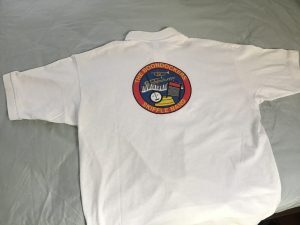
Once in a while I would sing a song with the band. My tips would double and triple. It was wonderful when the band played the patriotic medley at the end of the night. There were so many servicemen in our audience and they seemed to take it as seriously as I did. I was often not the only one with tears in my eyes. When I saw the Boondockers reunite at the Sacramento Dixieland Jazz Jubilee in 1998 and do the medley again, it brought tears again. An ol’ fart like me was standing near by, took off his hat, tears in his eyes, too. I bought the Boondockers CD and when I’m depressed, I sing the Patriotic Medley with the Boondockers and feel like myself again. — Sandi Meyer, Capone’s waitress, Portland, OR.
Over a period of 60 years, I worked at possibly 40 nightclubs. Playing piano for 16 ½ years at Capone’s was the most fun I ever had in the music business. — Bob Ringwald, musician.
Operating Capone’s during those many years was a fantastic experience and a very important part of my life. Having all those great employees and faithful customers is what made Capone’s so successful. Thanks to all and thanks to Bob Ringwald for writing this article. – Carlo Giordano, Capone’s owner.
Bob Ringwald is well-known to many fans of classic jazz as a bandleader, pianist, banjo/guitarist, vocalist, and radio DJ. He was the long-time leader of the Great Pacific Jazz Band of Los Angeles and the Fulton Street Jazz Band of Sacramento, California. He served on the Board of Directors of the Sacramento Traditional Jazz Society and was the Guest Star Coordinator for many years. He was also an original board-member of the International Sacramento Dixieland Jazz Jubilee. In 2012, Bob was honored by the Jazz Jubilee by being named the “Emperor of Jazz.”
Among many professional credits, he played intermission piano at Turk Murphy’s Earthquake McGoon’s in San Francisco, California, from 1970 to 1973. Bob produced and hosted a weekly 3 hour jazz radio show, titled Bob Ringwald’s Bourbon Street Parade in Los Angeles from 1979 to 1994. He is the father of three children, Beth Carnes, home-maker and mother, Kelly, fencer and rock climber and the actress, author and jazz singer Molly Ringwald. Bob now lives with Adele, his wife of 59 years, in the Sacramento area. He boasts 4 grandchildren and one great-grandson. He may be contacted at www.ringwald.com.






















